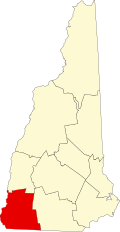Keene Unitarian Universalist Church | |
 | |
| Location | 69 Washington St., Keene, New Hampshire |
|---|---|
| Coordinates | 42°56′10″N72°16′38″W / 42.93611°N 72.27722°W |
| Built | 1894 |
| Architect | Edwin J. Lewis Jr. |
| Architectural style | Late Gothic Revival & Tudor Revival |
| NRHP reference No. | 100010873 [1] |
| Added to NRHP | September 27, 2024 |
The Keene Unitarian Universalist Church is a historic Unitarian Universalist church in Keene, New Hampshire. Constructed in 1894, [a] it was added to the New Hampshire State Register of Historic Places in 2021, [2] and the National Register of Historic Places in 2024. [3]


